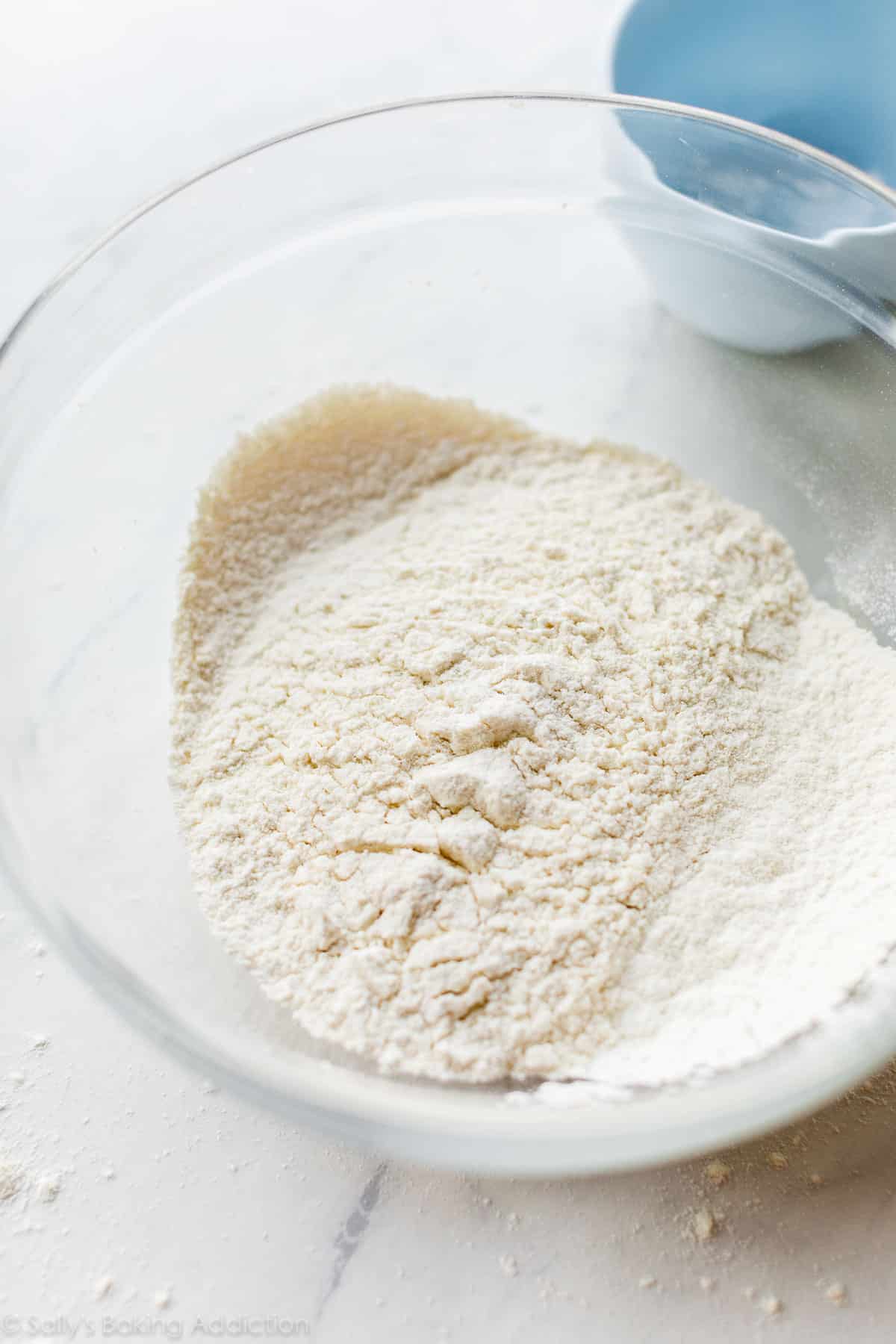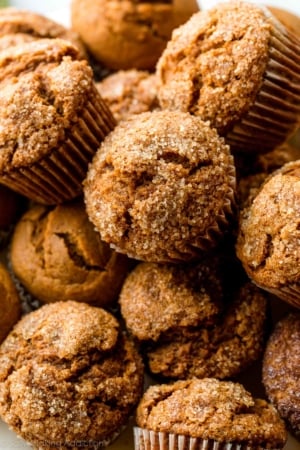You only need two common ingredients—all-purpose flour and cornstarch—to make a homemade cake flour substitute. Sifting them together is key.

As my baking experience grows, I use cake flour more and more in my baking. There’s no denying that cake flour produces the softest, most tender cakes and cupcakes. I try to keep my kitchen stocked with this crucial ingredient, but sometimes I quickly run out when I’m recipe testing. So in a pinch, I make this super easy cake flour substitute.
Let’s back up for a minute though.
What is Cake Flour?
Cake flour is a low protein flour that’s milled into a fine consistency. It contains about 7-9% protein, while all-purpose flour, a harder flour, has anywhere between 10-12%. What does this mean for baking? You see, protein content is directly related to gluten formation. Cake flour’s lower protein means less gluten is formed as you mix the batter together. Less gluten formation equates to a softer, fluffier texture.
Bread flour has a high protein content, which means more gluten forms during the mixing process. Super basic breakdown:
- Cake flour = low protein = less gluten = softest texture = great for vanilla cake and vanilla cupcakes
- All-purpose flour = medium protein = moderate gluten = suitable for anything, from chocolate chip cookies to pizza dough
- Bread flour = high protein = more gluten formation = hardest texture = great for artisan bread and bagels

What Does That Mean for Baking?
Cake flour’s soft, tender texture directly translates into your baked good.
However, some recipes simply can’t withstand fine cake flour. Chocolate cake, for example, already has cocoa powder– which is a VERY fine dry ingredient. The combination of cake flour and cocoa powder usually results in a flimsy cake. Additionally, carrot cake and banana cake contain additional wet ingredients (the fruits or veggies), so cake flour isn’t really ideal. You need a stronger flour like all-purpose flour.
I stick to cake flour when making vanilla cake, white cake, pineapple upside-down cake, red velvet cake, and other cakes where a fluffy texture is favorable. I’ve been successful substituting cake flour for all-purpose flour to create a softer 1-layer sprinkle cake. Make a 1:1 substitution with no other changes to the recipe.

How to Make a Homemade Cake Flour Substitute
Step 1: Sift 14 Tablespoons (110g) all-purpose flour and 2 Tablespoons (16g) cornstarch together two times.
Step 2: Measure (spoon & level) 1 cup from this mixture. You’ll have about 1 cup anyway, but sometimes sifting can produce more volume since it’s adding air.
Step 3: Now you have 1 cup of cake flour that you can use in most recipes requiring cake flour. If the recipe requires more than 1 cup cake flour, you can do this process in bulk, but I find it’s better to make each cup of cake flour separately.
Note that delicate baked goods meant to have an extraordinary light texture like angel food cake and white cake should ideally use real cake flour. If you’re in a pinch and don’t have cake flour for other recipes, use this substitute!



Items You Need
- Cornstarch
- All-Purpose Flour
- Sifter/fine mesh sieve
PS: Here’s the flour canister pictured above. I use these for my flour, granulated sugar, brown sugar, and confectioners’ sugar. They’re awesome!

If you’re purchasing cake flour, though, I’m happy to share my favorite brands. I love Swans Down and Softasilk. (Not working with either, just a genuine fan!) I use unbleached when I can find it, otherwise I just stick with bleached. Both brands provide quality results for a good price. You can find cake flour in the baking aisle next to the all-purpose flour.
By the way, I also have a helpful DIY buttermilk substitute, too!
Print
Homemade Cake Flour Substitute
- Prep Time: 2 minutes
- Cook Time: 0 minutes
- Total Time: 2 minutes
- Yield: 1 cup
- Category: Baking
- Method: Mixing
- Cuisine: American
Description
You only need two common ingredients—all-purpose flour and cornstarch—to make a homemade cake flour substitute. Sifting them together is key. Delicate baked goods meant to have an extraordinary light texture like angel food cake and white cake should ideally use real cake flour. If you’re in a pinch and don’t have cake flour for other recipes, use this substitute.
Ingredients
- 14 Tablespoons (110g) all-purpose flour (spooned & leveled)*
- 2 Tablespoons (16g) cornstarch
Instructions
- Sift flour and cornstarch together in a large bowl. Repeat so the mixture is sifted twice. Sifting not only mixes the two ingredients together appropriately, it aerates the mixture so the consistency is similar to real cake flour.
- Measure (spoon & level) 1 cup from this mixture. You’ll have about 1 cup anyway, but sometimes sifting can produce more volume since it’s adding air.
- Now you have 1 cup of cake flour that you can use in any recipes requiring cake flour. If the recipe requires more than 1 cup cake flour, you can do this process in bulk, but I find it’s better to make each cup of cake flour separately.
Notes
- Special Tools (affiliate link): Sifter/Fine Mesh Sieve
- You need 14 Tablespoons (3/4 cup + 2 Tablespoons; 110g) of spoon & leveled all-purpose flour. Sometimes it’s easier to measure 1 cup (16 Tablespoons) then remove 2 Tablespoons than to individually measure 14 Tablespoons. Alternatively, you could measure 3/4 cup flour then add 2 Tablespoons.
- Cornstarch is extra fine and lowers the gluten formation in the all-purpose flour, similar to cake flour. In the UK, cornstarch is referred to as corn flour. Make sure you are not using cornmeal. They are completely different ingredients.





















What is the difference between bleached and unbleached all purpose flour and are certain cake recipes best using one over the other
Hi Karen, here’s a helpful article on the difference between bleached and unbleached flour: https://www.kingarthurbaking.com/blog/2023/11/16/bleached-vs-unbleached-flour We prefer to use unbleached flour when possible.
Can I bake a carrot cake in a 14×10 pan rather 13×9 pan at 350 degree and shorten bake time?
Hi Gloria, here’s everything you need to know about cake pan sizes and conversions.
Hi, let’s see if I understand, how much cornstarch do I put in and what do I take out of the flour? For example: if it’s 100g of flour and I add the spoons, 16g of starch, do I add 84g of flour?
Hi Luis, you’ll want to sift together 110g of all-purpose flour and 16g of cornstarch.
Can the cake flour substitute be used to make your red velvet cake?
Hi Sally, it can in a pinch, but for that particular cake, it’s best to use real cake flour.
Thank you for this recipe. I live in Costa Rica now and am unable to find Swansdown or other cake flour for my angel food cakes.
I think this cake flour will be perfect to make angel food cake
Can I substitute arrow root to corn starch
Hi Rani, we haven’t tested it, but arrowroot powder should work. Let us know if you give it a try!
Can I use an electric whisk to blend the cake flour instead of the sifter?
Hi Roxanne, you could simply use a whisk instead.
Perfect because wanted to do homemade cake flour by weight, but I’m confused by note 1. The point of 14 tablespoons of flour (7/8 cup) plus 2 tablespoon of cornstarch (1/8 cup) is to yield one cup of cake flour. But in that last sentence you say to measure 3/4 cup flour (12 tablespoons) and add 2 tablespoons of cornstarch, so you’re missing 2 tablespoons of flour, no?
Hi Sean, we’re happy to help clarify. The note is only referring to the flour. To measure the 14 tablespoons of flour needed, you can either (1) measure 3/4 cup of flour + 2 tablespoons of flour OR (2) measure 1 cup of flour and then remove 2 Tablespoons of flour. Either way will leave room for 2 Tablespoons of cornstarch needed to make the cake flour mix. Hope this helps.
Hello! Can I substitute cake flour for all purpose flour equally in cookie recipes (1:1)? If so, should I then omit the addition of cornstarch? Thank you!
Cake flour would yield a lighter, more delicate texture in cookies, but we always use and recommend all-purpose flour for our cookie recipes.
1 cup of flour is 125 grams. so 125 grams minus 2 tbsps (16g), would equal 109 grams of flour, not 110 grams, correct?
Hi Cindy, yes, I weigh 1 cup of spooned and leveled flour to be 125g. 2 Tablespoons is about 15.6g, so you’ll need between 109-110g. That small of a difference won’t really matter in a recipe. I hope I’m understanding your question?
I am so glad that I ran across your cake flour substitute. I normally don’t buy cake flour and now I know I can make a cake that calls for cake flour without making a special trip to the store. Can’t wait to try your pineapple cake recipe!
What if I have bread flour how can I make cake flour if possible?
We don’t recommend using bread flour in place of cake flour, as the protein content is so vastly different.
I haven’t found gluten free cake flour. So I use your recipe and use a gluten free 1 to 1 type flour with the cornstarch and it’s perfect. Thanks so much! I use gluten free 1 to 1 with all your recipes and I’ve never had a bad one!
Love your recipes! Making a cake for work (lemon berry) in which you call for cake flour. As I have a co-worker with Celiac’s I picked up some Bob’s Red Mill 1 to 1 substitute. Since this is already gluten free, do you know if should I still add the cornstarch? Thanks in advance-
Hi Juli, We haven’t tested making a gluten free cake flour substitute, but we would imagine you would still add the cornstarch. If you try it, let us know how it goes!
I use all of Sally’s recipes with gluten free 1 to 1 and they have all turned out wonderful! I make cake flour with it also.
I am a FACS teacher and teach a baking class. What would be the best way to teach how to properly measure 2/3 cup of cake flour? The students are making the Best Vanilla Cake recipe off your website.
Hi Kelly! We would follow the cake flour “recipe” above (which yields about 1 cup), then measure 2/3 cup (spoon and leveled) from there.
This recipe helped a lot. Thank you!